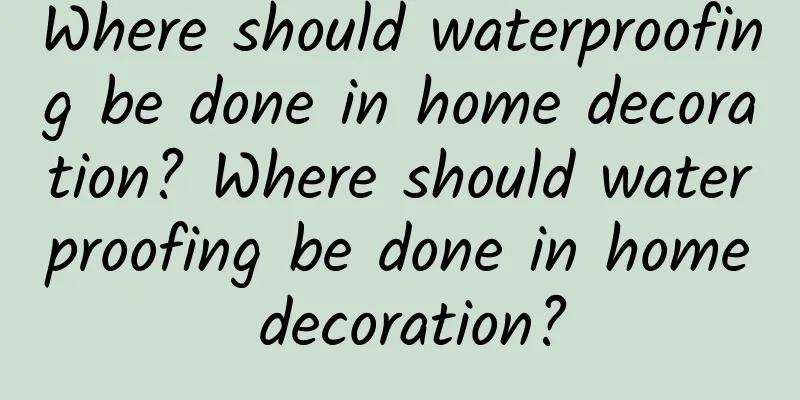Where should waterproofing be done in home decoration? Where should waterproofing be done in home decoration?

|
We all know that when renovating a house, waterproofing is generally required, mainly in places where water is used at home, such as bathrooms, kitchens, balconies, etc. In addition to these places, there are other places that also need waterproofing. So which places in the house should be waterproofed when renovating? Let's take a closer look! Which parts of the house should be waterproofed?Bathroom waterproofingThe bathroom is the first place that needs waterproofing. The bathroom is often used for bathing, so waterproofing is essential. First, check whether the sewer pipes in the bathroom are intact, and then do the first waterproofing. Waterproofing cannot only be done on the surface of the floor, but also on the surrounding walls. After the waterproofing is done, wait for it to dry, and then do the second waterproofing. After the completion, test it with water to see if there are any leaks. Kitchen waterproofingThe kitchen floor should be waterproofed. There will be less splashing of water on the kitchen floor, but water will also flow to the ground when washing things, so the kitchen should also be waterproofed. There are many floor drains and pipes in the kitchen, which are relatively humid, so the adjacent areas should also be waterproofed. Balcony waterproofingSome families do not waterproof the balcony, some families have only one balcony, and some families have large and small balconies. The large balcony is usually connected to the living room, and the small balcony will be used to place washing machines and other home appliances. At this time, waterproofing is very necessary. Bay window waterproofMany families do not waterproof bay windows, thinking that it is useless. However, bay windows are usually extended out and protrude from the wall for a distance. If it rains continuously, it will be very humid. If the bay windows are large or not closed, water will enter and slowly corrode the decoration materials. Therefore, it is better to waterproof the bay windows. Which places need waterproofing but are generally not waterproofedThere are mainly the following places: 1. Around all sewer pipesThe main function of the sewer pipe is to drain water, so waterproofing should be done wherever there is drainage. Since there is a high probability that the sewer pipe will have poor drainage in the future, and there may be long-term moisture problems near the sewer pipe, it is recommended that waterproofing be applied around all sewer pipes to avoid small-scale leakage affecting other residents. 2. Indoor toilets share a wallThe indoor bathroom shared wall refers to the wall that separates the bathroom from the indoor room. This wall is directly separated from the bathroom, and many wardrobes are placed here. Considering that moisture may penetrate through the wall to the back of the wardrobe, and because the back of the wardrobe is poorly ventilated, it is very easy to breed bacteria. Therefore, it is recommended that all bathroom walls be painted 50 to 80 cm high, and the shower area be painted 2 meters high; the indoor shared wall is fully painted with waterproofing; when economic conditions permit, the wall behind the wardrobe can be fully painted with transparent waterproofing; (the wall is selected in the red box in the figure below) 3. The ground floor of the first floor residentsThe first floor is the lowest floor, with short exposure to sunlight. Even if there is an overhead floor, moisture may still gather behind furniture and underground. Therefore, it is recommended that residents living on the first floor add waterproof coatings to all bedroom floors, which can effectively extend the service life of the floors and effectively prevent moisture from the ground. When conditions permit, the entire floor of the house can be painted with waterproof coatings. 4. All window edgesWater seepage at the edges of windows is very common, especially during the rainy season. After the developer installs the windows, they will use structural adhesive on the exterior wall as a waterproof material. Since aging of the exterior wall structural adhesive is only a matter of time, it is recommended that ordinary waterproof paint be applied to the inside of all window edges, and special outdoor waterproof paint be applied to the exterior wall of the window edges. Actual measurements have shown that this can effectively prevent water seepage problems and extend the life of the structural adhesive. How to waterproof the house decorationbathroomBefore waterproofing the bathroom, the caisson needs to be rinsed clean first, because the dust and sand originally in the caisson will seriously affect the effect of the waterproof layer, causing bubbles or bulging, and once it breaks, the waterproof effect will not be achieved. Therefore, before waterproofing, you should install the drainage pipe and water inlet pipe first. The water inlet pipe must not enter the bathroom directly from under the door threshold, because water will leak along the smooth pipe wall to the downstairs or room. When it is outside the bathroom, you should drill a hole more than 35cm from the wall and then lay the pipe inside the bathroom. After laying the pipes, backfill them completely with cement mortar, tamp them, apply a layer of cement oil, do secondary drainage and bottom drainage, and brush on waterproofing to make it foolproof. balconyTo waterproof the balcony, you just need to apply waterproof paint twice from the entire ground to the base of the guardrail, block the drain outlet, fill it with water and test it for 48 hours. If there is no leakage, there will basically be no problem with backfilling and laying tiles. kitchenThe third is the waterproofing of the kitchen. In fact, Xiao Fan personally suggests that the kitchen does not need waterproofing. Waterproofing usually occurs only where there is a drain. The drain of the kitchen sink is usually about 25cm from the ground. There is no drain on the floor, so waterproofing will not work. Water will still accumulate and seep to the side. Therefore, the most important thing in the kitchen is to install and seal the drain pipe of the sink, and pay attention to the design of the kitchen cabinets and sink cabinets. |
>>: When does the BCG scab fall off? How to tell whether the BCG vaccination is successful?
Recommend
Can I eat Korean barbecue when I am pregnant?
After becoming pregnant, women will experience mo...
Why is the vaginal discharge like jelly and elastic?
Why is it that the leucorrhea is very elastic whe...
What are the causes of endometriosis?
The condition of endometrial displacement is orig...
Five and a half months of pregnancy
What does the fetal picture look like in the fift...
Are pelvic cysts serious?
The appearance of pelvic cysts will definitely ca...
How to treat blisters on the labia
Many women are prone to gynecological diseases du...
What is the cause of heavy menstrual flow and black blood clots?
The menstrual period is the most vulnerable time ...
No more than 5 grams of salt per person per day
# Thousands of IPs Create Science Popularization ...
What should I do if I have brown discharge before my period?
Menstruation is the shedding of the endometrium a...
Can fungal vaginitis heal itself?
Vaginitis candida is a disease that everyone is c...
Does unfiltered coffee raise blood lipids? Research finds that this is actually the case...
Coffee has become an indispensable drink in the l...
What causes vaginal itching and abnormal leucorrhea?
For women, the most common and mildest gynecologi...
Watery menstrual blood
Watery menstrual blood is caused by endocrine dis...
Move around to keep your bones strong
This is the 4041th article of Da Yi Xiao Hu Let m...









